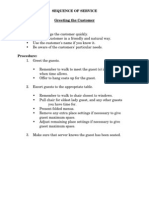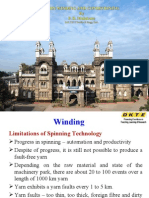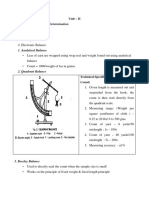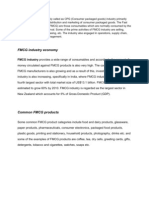Wool and Worsted Yarn
Wool and Worsted Yarn
Uploaded by
raghavbindalCopyright:
Available Formats
Wool and Worsted Yarn
Wool and Worsted Yarn
Uploaded by
raghavbindalCopyright
Available Formats
Share this document
Did you find this document useful?
Is this content inappropriate?
Copyright:
Available Formats
Wool and Worsted Yarn
Wool and Worsted Yarn
Uploaded by
raghavbindalCopyright:
Available Formats
http://ntupk.academia.
edu/AAzeem
Wool and Worsted Yarn
Basically, there are two types of yarns, each with its own method of fiber preparation and spinning techniques. They are: Woolen and Worsted.
Wool Yarn
Wool is the dense, warm , soft, often curly hair forming coat of sheep, also called a fleece. Wool is readied by washing (lanolin is the by-product), carding, sometimes combing, then spinning. Wool is warm and lightweight and takes dyes well. Woolens are spun from carded preparations. Woolen yarns, usually made from shorter fibres, are thick and full and are used for such items as tweed fabrics and blankets.
Background:As with many discoveries of early man, anthropologists believe the use of wool came out of the challenge to survive. In seeking means of protection and warmth, humans in the Neolithic Age wore animal pelts as clothing. By 4000 B.C., Babylonians were wearing clothing of crudely woven fabric. People soon began to develop and maintain herds of woolbearing animals. During the eleventh and twelfth centuries, wool trade prospered. Today, wool is a global industry, with Australia, Argentina, the United States, and New Zealand serving as the major suppliers of raw wool. While the United States is the largest consumer of wool fabric, Australia is the leading supplier. Australian wool accounts for approximately one-fourth of the world's production.
Production:The annual global output is now estimated at 5.5 billion pounds. Though cotton is the number one plant used for fabrics and the number one fiber overall, the number one source for animal fiber is still wool. Wool and Worsted Yarn Page 1
http://ntupk.academia.edu/AAzeem
The Manufacturing Process:The major steps necessary to process wool from the sheep to the fabric are: shearing, cleaning and scouring, grading and sorting, carding, spinning, weaving, and finishing.
Shearing:Sheep are sheared once a yearusually in the springtime. A veteran shearer can shear up to two hundred sheep per day. The fleece recovered from a sheep can weigh between 6 and 18 pounds (2.7 and 8.1 kilograms); as much as possible, the fleece is kept in one piece. While most sheep are still sheared by hand, new technologies have been developed that use computers and sensitive, robot-controlled arms to do the clipping.
Grading and sorting:Grading is the breaking up of the fleece based on overall quality. In sorting, the wool is broken up into sections of different quality fibers, from different parts of the body. The best quality of wool comes from the shoulders and sides of the sheep and is used for clothing; the lesser quality comes from the lower legs and is used to make rugs. In wool grading, high quality does not always mean high durability.
Cleaning and scouring:Wool taken directly from the sheep is called "raw" or "grease wool." It contains sand, dirt, grease, and dried sweat (called suint); the weight of contaminants accounts for about 30 to 70 percent of the fleece's total weight. To remove these contaminants, the wool is scoured in a series of alkaline baths containing water, soap, and soda ash or a similar alkali. The byproducts from this process (such as lanolin) are saved and used in a variety of household products. Rollers in the scouring machines squeeze excess water from the fleece, but the fleece is not allowed to dry completely. Following this process, the wool is often treated with oil to give it increased manageability.
Carding:Next, the fibers are passed through a series of metal teeth that straighten and blend them into slivers. Carding also removes residual dirt and other matter left in the fibers. Carded wool intended for worsted yarn is put through gilling and combing, two procedures that remove short fibers and place the longer fibers parallel to each other. From there, the sleeker slivers are compacted and thinned through a process called drawing. Carded wool to be used for woolen yarn is sent directly for spinning.
Wool and Worsted Yarn
Page 2
http://ntupk.academia.edu/AAzeem
Spinning:Thread is formed by spinning the fibers together to form one strand of yarn; the strand is spun with two, three, or four other strands. Since the fibers cling and stick to one another, it is fairly easy to join, extend, and spin wool into yarn. Spinning for woolen yarns is typically done on a mule spinning machine, while worsted yarns can be spun on any number of spinning machines. After the yarn is spun, it is wrapped around bobbins, cones, or commercial drums.
Weaving:Next, the wool yarn is woven into fabric. Wool manufacturers use two basic weaves: the plain weave and the twill. Woolen yarns are made into fabric using a plain weave (rarely a twill), which produces a fabric of a somewhat looser weave and a soft surface (due to napping) with little or no luster. The napping often conceals flaws in construction. Worsted yarns can create fine fabrics with exquisite patterns using a twill weave. The result is a more tightly woven, smooth fabric. Better constructed, worsteds are more durable than woolens and therefore more costly.
Finishing:After weaving, both worsteds and woolens undergo a series of finishing procedures including: fulling (immersing the fabric in water to make the fibers interlock); crabbing (permanently setting the interlock); decating (shrink-proofing); and, occasionally, dyeing. Although wool fibers can be dyed before the carding process, dyeing can also be done after the wool has been woven into fabric.
Wool and Worsted Yarn
Page 3
http://ntupk.academia.edu/AAzeem
Spinning of woolen yarn:Woolen yarn is handspun using the long draw technique, and the yarn is spun from a rolag and thus ending up with a mix. The first step to spin a true woolen yarn, however, is to card the fiber into a rolag using hand carders. The rolag is spun without much stretching of the fibers from the cylindrical configuration. This is done by allowing twist into a short section of the rolag, and then pulling back, without letting the rolag change position in your hands, until the yarn is the desired thickness. The twist will concentrate in the thinnest part of the roving, thus when the yarn is pulled, the thicker sections with less twist will tend to thin out. Once the yarn is the desired thickness, enough twist is added to make the yarn strong. Then the yarn is wound onto the bobbin, and the process starts again.
Quality:The quality of wool is determined by the following factors, fiber diameter, crimp, yield, colour, and staple strength. Fiber diameter is the single most important wool characteristic determining quality and price.
Grade:Wool is also separated into grades based on the measurement of the wool's diameter in microns and also its style. These grades may vary depending on the breed or purpose of the wool. For example:
<15.5 - Ultrafine Merino 15.6-18.5 - Superfine Merino 18.6-20 - Fine Merino
Wool and Worsted Yarn
Page 4
http://ntupk.academia.edu/AAzeem
20.1-23 - Medium Merino 23< - Strong Merino Comeback: 21-26 microns, white, 90180 mm long Fine crossbred: 27-31 microns, Corriedales etc. Medium crossbred: 3235 microns Downs: 23-34 microns, typically lacks luster and brightness. Examples, Aussiedown, Dorset Horn, Suffolk etc. Coarse crossbred: 36> microns Carpet wools: 35-45 microns
PROPERTIES AND CHARACTERISTICS: Crimp:It is caused by the unique chemical and physical properties of wool. The fiber tends to bend and turn in to a resilient 3 dimensional structure. It holds in air to insulate the wearer. This property make wool naturally elastic and resilient causing rapid wrinkle recovery, durability, bulk, loft, warmth, and resistance to abrasion.
Water Absorbency:Wool can absorb up to 30% of its weight in moisture without feeling damp or clammy. This makes wool good for all climates since it aids in the body's cooling mechanisms to keep moisture away from the skin. Its moisture regain is 16%.
Resistance to Fire:Wool contains moisture in every fiber allowing it to resist flame without any additional chemical treatment. The wool will just char and self extinguish.
Dyeability:Wool absorbs many dyes deeply, uniformly, and directly without the use of chemicals. This characteristic allows wool to achieve very beautiful and rich colors when dyed.
Durability:The flexibility of wool makes it very durable. A single wool fiber can be bent back on itself more the 20,000 times without breaking. Compare this to the only 3,000 times of cotton and 2,000 times of silk. Its elasticity makes it very resistant to tearing. Wool also has an outer film making it resistant to abrasion.
Resilience:-
Wool and Worsted Yarn
Page 5
http://ntupk.academia.edu/AAzeem
Wool fiber can be stretched up to 50% of its length when dry and up to 30% of its length when wet without breaking It will return to its original length when released.
Flammability:Wool is popular with interior designers because it is considered naturally flame retardant. While it will burn if exposed to flame, it burns slowly. When the flame is removed, the fabric usually quits burning.
Pilling:Pilling is a surface fault characterised by the formation of little pills of entangledfibre on the surfaceof the fabric. The formation of pills occurs during wear, washing and tumble drying by loose fibres protruding from the fabric and becoming entangled. When rubbed, the loose fibres bundle up intosmall balls, anchored to the fabric by a few unbroken fibres.
Prickle:Prickle and skin reactions are important comfort factors related to a fabrics handle and performance. Prickle results from fibre ends on the fabric surface indenting the skin sufficiently to activate pain receptors. The handle characteristics of wool fabric is influenced by the fineness of the fibres in the fabric structure the coarser the fibre the greaterthe chance of prickle. Fibre length is also likely to influence prickle, since it will affect the number of fibre ends per unit area of fabric surface.
Shrinkage:The scaly surface of the wool fibre gives wool products the potential to felt when milled or agitated in water under harsh washing conditions. The scales on the fibre surface lock together causing the garment to reduce in size and become thick and fluffy (felted). Advantage is taken of this to make a wide range of semi-felted apparel fabrics such as flannels. Partial felting, giving wool yet another advantage in terms of versatility, texture and comfort can control the porosity of a fabric to cold winds and rain.
More properties: They are 1-14 in (2.54-35.56 cm) or more in length, with diameters of 1/600th1/3,000th in (0.04-0.008 mm). Their average chemical compositions are: carbon, 50%; hydrogen, 7%; oxygen, 2225%; nitrogen, 16-17%; and sulphur, 3-4%. They are extremely flexible and can be bent 20,000 times without breaking.
Wool and Worsted Yarn
Page 6
http://ntupk.academia.edu/AAzeem
They are capable of trapping air and providing insulation. They are thermally stable, and begin to decompose only at 212F (100C). Strength is from 1.0-1.7 g.p.d. Strength decreases ith moisture. Overal tensile strength of oolen yarn i 17000-29000 sq.inch.
End Uses of wool:
Wool is used to make sweaters, dresses, coats, suits, jackets, pants and the lining of boots. It can also be made into blankets and carpets. Merino wool has been used in baby sleep products such as swaddle baby wrap blankets and infant sleeping bags. Wool is an animal protein, and as such it can be used as a soil fertiliser, being a slow release source of nitrogen and ready made amino acids. The two major end uses for wool are apparel products and carpets (both machine made and hand-knitted). Wool has also been traditionally used to cover cloth diapers.
Worsted Yarn
Worted is Firm-textured, compactly twisted woolen yarn made from longstaple fibers. Worsted is the name of a yarn, the cloth made from this yarn, and a yarn weight category. This type of wool is made of long-staple fibers that have been combed to remove unwanted short fibers and make them lie parallel. The fibers are then tightly twisted and woven tightly as well which inhibits creasing. It is popular for suits and trousers.
History:Prior to the introduction of automatic machinery there was little difficulty in attaining a straight fibre, as long wool was always used, and the sliver was made up by hand, using combs. However, with the introduction of Richard Arkwright's water frame in 1771, and the
Wool and Worsted Yarn
Page 7
http://ntupk.academia.edu/AAzeem
later introduction of cap and mule spinning machines, the need for perfectly prepared slivers became apparent, and many manufactories used one or more preparatory "gill-boxes" (combing machines) before the worsting process, to ensure straightness of fiber and distribute the lubricant evenly.
Preparation:The essential feature of a worsted yarn is straightness of fiber, in that the fibers lie parallel to each other. Traditionally, long, fine staple wool was spun to create worsted yarn, but other long fibers are also used today. Worsted preparation refers to the way the fiber is prepared before spinning, using gilling machines which force the fiber staples to lie parallel to each other. They are then combed to remove the short fibers. The long fibers are combined in subsequent gilling machines to again make the fibers parallel. This produces overlapping untwisted strands called slivers. Worsted spinning refers to using a worsted technique, which produces a smooth yarn where the fibers lie parallel. Roving and wool top are often used to spin worsted yarn. Top and roving are ropelike in appearance, in that they can be thick and long. While some mills put a slight twist in the ravings they make, it is not enough twist to be a yarn. The fibers in top and ravings all lie parallel to one another along the length, which makes top ideal for spinning worsted yarns. Worsted-spun yarns, used to create worsted fabric, are spun from wool fibers that have been combed, to ensure that the woolen fibers all run the same direction, butt-end (end that was cut in shearing the sheep) to tip, and remain parallel. A short draw is used in spinning worsted fibers (as opposed to a long draw). In short draw spinning, spun from combed roving, sliver or wool top, the spinners keep their hands very close to each other. The fibers are held fanned out in one hand while the other hand pulls a small number from the mass. The twist is kept between the second hand and the wheel there is never any twist between the two hands.
Wool and Worsted Yarn
Page 8
http://ntupk.academia.edu/AAzeem
Spinning of worsted yarn:Worsted is spun from a combed fiber preparation. Combing removes the short fibers from the locks, leaving a preparation, which has fibers of very similar staple lengths, and it prepares the fibers by aligning them so that they are strictly parallel to each other. The spinning method is either short backwards or short forward draw. The yarn is firm, strong and smooth with low loft, low elasticity, and it is not fuzzy. Worsted yarns are spun from long stapled fibers - over 4", though some authors say over 3". The yarns are sometimes called "summer weight wools" because worsteds are cooler to wear than woolens.
Features: Length of the sheared fiber is called the staple length. Different breeds of sheep produce different staple lengths, but they average between 2 inches for fine wools and 12 inches for long coarser wools. Manufacturers usually use long fiber wool because it wears better. They can spin it with a lot of twist. Fabric made from worsted wool, including hand knit sweaters, will feel warm and dry against your skin even when wet Worsted is too hygroscopic and can absorb up to 30 percent of its weight in moisture. Worsted wool is also naturally flame retardant, which makes it a good choice for baby and firemen's blankets alike. It is resilient and quickly returns to its natural shape
Wool and Worsted Yarn
Page 9
http://ntupk.academia.edu/AAzeem
Worsted is lightweight and has a coarse texture. Worsted yarns are spun from long stapled fibers - over 4", though some authors say over 3".
Uses:
The weave is usually twill or plain. Twilled fabrics such as whipcord, gabardine and serge are often made from worsted yarn. Worsted fabric made from wool has a natural recovery, meaning that it is resilient and quickly returns to its natural shape, but non-glossy worsted will shine with use or abrasion. Worsteds differ from woollens, in that the natural crimp of the wool fibre is removed in the process of spinning the yarn. In Tropical Worsteds this use of tightly-spun straightened wool combined with a looser weave permits the free flow of air through the fabric. Worsted is also used for carpets, garments, hosiery, gloves.
Wool and Worsted Yarn
Page 10
You might also like
- Detailed Sequence of Service SteakhouseDocument8 pagesDetailed Sequence of Service Steakhousejanelle_1976No ratings yet
- Single Jersey FabricDocument4 pagesSingle Jersey FabricMrcr Kapzap0% (1)
- Staple Cotton Spinning SystemsDocument24 pagesStaple Cotton Spinning Systemsagga1111No ratings yet
- Wool SpinningDocument68 pagesWool SpinningCẩm Tú100% (1)
- Instruction Manual: HD 6600C - HD 6605CDocument38 pagesInstruction Manual: HD 6600C - HD 6605CfatagiuNo ratings yet
- The Delicious CookbookDocument306 pagesThe Delicious Cookbookchefyousef100% (14)
- Electrical Plan Design RubricDocument1 pageElectrical Plan Design Rubricapi-25981522100% (2)
- Mike Prevost Quick Guide To Transitioning To Running SandalsDocument8 pagesMike Prevost Quick Guide To Transitioning To Running Sandalsamaru.writer100% (1)
- Classification of FibresDocument12 pagesClassification of FibresARYAN RATHORENo ratings yet
- The Textiles Student's Manual - An Outline of All Textile Processes, From the Origin of the Fibre to the Finished ClothFrom EverandThe Textiles Student's Manual - An Outline of All Textile Processes, From the Origin of the Fibre to the Finished ClothRating: 4 out of 5 stars4/5 (1)
- Manufacture of Narrow Woven Fabrics - Ribbons, Trimmings, Edgings, Etc. - Giving Description of the Various Yarns Used, the Construction of Weaves and Novelties in Fabrics Structures, also Desriptive Matter as to Looms, Etc.From EverandManufacture of Narrow Woven Fabrics - Ribbons, Trimmings, Edgings, Etc. - Giving Description of the Various Yarns Used, the Construction of Weaves and Novelties in Fabrics Structures, also Desriptive Matter as to Looms, Etc.No ratings yet
- Different Formulas of Weaving CalculationDocument4 pagesDifferent Formulas of Weaving CalculationMaaz Yafeez GanatraNo ratings yet
- 2 - Properties of Textile FibresDocument17 pages2 - Properties of Textile FibresZain MalikNo ratings yet
- Yarn Count & Yarn ModificationDocument52 pagesYarn Count & Yarn Modificationmhrscribd014100% (2)
- Textile Yarns PDFDocument35 pagesTextile Yarns PDFVu Ngo Tuan100% (1)
- Advances in Weaving Technol...Document9 pagesAdvances in Weaving Technol...Fabric Club100% (1)
- Fabric Science-Ii: Subject Code: 17UTF09Document111 pagesFabric Science-Ii: Subject Code: 17UTF09Sweatha S100% (1)
- Advanced SpinningDocument130 pagesAdvanced SpinningSivakumar K100% (5)
- F Ancy Yarn Production: Chapters 2 3Document19 pagesF Ancy Yarn Production: Chapters 2 3TKK-TEXTILE PSG CT100% (1)
- SpinningDocument199 pagesSpinningJalal Uddin RumiNo ratings yet
- Basic Terminologies For Fabric KnittingDocument3 pagesBasic Terminologies For Fabric KnittingVasant Kothari100% (2)
- Knitting MachineDocument19 pagesKnitting MachineShamima akterNo ratings yet
- Dobby Rapier LoomDocument6 pagesDobby Rapier LoomVaibhav GaikwadNo ratings yet
- Yarn Manufacturing Gate QuestionsDocument190 pagesYarn Manufacturing Gate QuestionsSantoshNo ratings yet
- Yarn TexturingDocument33 pagesYarn TexturingAbdul QadeerNo ratings yet
- 2 GinningDocument29 pages2 GinningPrincesaxena SaxenaNo ratings yet
- Unit 2Document76 pagesUnit 2Vaibhav SinglaNo ratings yet
- Factors Determining The Prominence of Twill WeavesDocument11 pagesFactors Determining The Prominence of Twill Weaveswaqas104No ratings yet
- Yarn WindingDocument22 pagesYarn WindingPRAKASH B. MALAKANE0% (1)
- KnittingDocument9 pagesKnittingdevenderpal48No ratings yet
- Study On Denim and Gabardine Twill Fabric Cover FactorDocument47 pagesStudy On Denim and Gabardine Twill Fabric Cover FactorAtik U Bhuiyan71% (7)
- Fiber Length: Bgmea University of Fashion & TechnologyDocument11 pagesFiber Length: Bgmea University of Fashion & TechnologySayed Islam ShakilNo ratings yet
- Weaving Commission CalculationsDocument1 pageWeaving Commission Calculationsraj_85No ratings yet
- Process Flow Chart of Knitting: A. Stitch LengthDocument9 pagesProcess Flow Chart of Knitting: A. Stitch LengthAushru Hasan100% (1)
- Yarn AssignmentDocument10 pagesYarn AssignmentHIMASHA SAMARANAYAKA100% (2)
- Fiber Fineness, Yarn Counts and ConversionsDocument11 pagesFiber Fineness, Yarn Counts and ConversionsBhaskar LoganathanNo ratings yet
- WeavingDocument51 pagesWeavingSofiane Sou100% (5)
- Slub YarnDocument15 pagesSlub YarnMoustafa Abdeltwab100% (2)
- Shuttle Less Weaving 1Document9 pagesShuttle Less Weaving 1sethup_1No ratings yet
- Chapter 1Document31 pagesChapter 1ProfessorTextechNo ratings yet
- Melange Yarn: 2. What Are The Applications of Mélange Yarn?Document2 pagesMelange Yarn: 2. What Are The Applications of Mélange Yarn?Md Ariful IslamNo ratings yet
- Fabric StructuresDocument90 pagesFabric StructuresNil Roy100% (1)
- ,loom TimingDocument23 pages,loom TimingDipesh Jain67% (3)
- Ring Spinning MachineDocument11 pagesRing Spinning MachineNavneet JainNo ratings yet
- Textile DictionaryDocument16 pagesTextile DictionaryRANG2812No ratings yet
- Types of FiberDocument47 pagesTypes of FiberUmar Mohammad100% (1)
- Reference Books of Textile Technologies - Finishing - Pietro Bellini Et Al. (ACIMIT, 2006)Document253 pagesReference Books of Textile Technologies - Finishing - Pietro Bellini Et Al. (ACIMIT, 2006)Syed Ijlal Haider75% (4)
- Yarn Count VHS 703: Submitted by Name Pooja (H.S) Neelam CLASS M .Voc (A.M)Document27 pagesYarn Count VHS 703: Submitted by Name Pooja (H.S) Neelam CLASS M .Voc (A.M)Anonymous UoRu4s100% (1)
- Production, Properties and Uses of Silk FiberDocument25 pagesProduction, Properties and Uses of Silk FibersandhyaRanimohantyNo ratings yet
- Unit - IiDocument27 pagesUnit - IiJoseph KuruvilaNo ratings yet
- Short Fiber SpinningDocument111 pagesShort Fiber Spinningnminhtuan883116100% (1)
- Weaving Calculation & Useful Formulas:: 1. CountDocument13 pagesWeaving Calculation & Useful Formulas:: 1. CountMusa Miah0% (1)
- Welt and PiqueDocument16 pagesWelt and PiquekritiNo ratings yet
- SpinningDocument8 pagesSpinningAishee Bhowmick100% (2)
- Yarn Manufacturing 3Document12 pagesYarn Manufacturing 3Muhammad Farooq Kokab0% (1)
- Circular KnittingDocument13 pagesCircular KnittingZahid HossainNo ratings yet
- Fabric Manufacturing - I Unit 1Document25 pagesFabric Manufacturing - I Unit 1Vijay KhoiwalNo ratings yet
- The Process Flow of Drawing-In and Tying-InDocument7 pagesThe Process Flow of Drawing-In and Tying-InRehan Saeedi100% (1)
- Friction SpinningDocument28 pagesFriction SpinningSiva Jagadish Kumar M100% (2)
- Some Important Weaving CalculationsDocument3 pagesSome Important Weaving CalculationsRagavendhiran ChandrasekaranNo ratings yet
- Count" of Yarn Folded YarnsDocument6 pagesCount" of Yarn Folded Yarnssakshi ranadeNo ratings yet
- Patterning in Weft Knitting: Waqas AshrafDocument33 pagesPatterning in Weft Knitting: Waqas AshrafHifza khalidNo ratings yet
- Textile Fibre Yarn CountDocument30 pagesTextile Fibre Yarn CountSujit GulhaneNo ratings yet
- Mukesh WorkDocument16 pagesMukesh WorkGargee BiswasNo ratings yet
- Major Facts:: Situational Analysis: Porter's Five Force AnalysisDocument3 pagesMajor Facts:: Situational Analysis: Porter's Five Force AnalysisHardik JadavNo ratings yet
- Food 12345Document57 pagesFood 12345VỸ TRẦNNo ratings yet
- Dish Washer: Owner'S ManualDocument68 pagesDish Washer: Owner'S ManualnictantesNo ratings yet
- C Provides A Wide Range of Consumables and Accordingly The Amount ofDocument4 pagesC Provides A Wide Range of Consumables and Accordingly The Amount ofnawaljainNo ratings yet
- Areas of The Restaurant 1. Receiving Area 4. Cooking AreaDocument4 pagesAreas of The Restaurant 1. Receiving Area 4. Cooking AreaJoseph Louis Bautista0% (1)
- ZanussiDocument32 pagesZanussiviral_christian2513No ratings yet
- Marketing MCQ First Chapter.Document117 pagesMarketing MCQ First Chapter.Tamboli Iqbal100% (1)
- TutorialWeek 2 Chap3-4 (ANS)Document20 pagesTutorialWeek 2 Chap3-4 (ANS)blaweewenNo ratings yet
- Miele WDA 100 Washing MachineDocument72 pagesMiele WDA 100 Washing Machinecolincharles682710No ratings yet
- Holiday Cookies: HomemadeDocument16 pagesHoliday Cookies: HomemadeInternalJoy100% (1)
- Portable Dryer 2.6 Cubic Feet: Owners ManualDocument18 pagesPortable Dryer 2.6 Cubic Feet: Owners Manualmember1000No ratings yet
- SOP 15-001 May 15, 2014 July 1, 2010 Attachment ADocument2 pagesSOP 15-001 May 15, 2014 July 1, 2010 Attachment AJayant Kumar JhaNo ratings yet
- Tle 6 AnotherDocument2 pagesTle 6 Anotherarre jay m cercadoNo ratings yet
- Anirban Bose: MOBILE NO: 08073153501. 08111111470 Emai LDocument8 pagesAnirban Bose: MOBILE NO: 08073153501. 08111111470 Emai LANIRBAN BOSENo ratings yet
- 125CC Parts Price List For Horizontal Engine - CustDocument31 pages125CC Parts Price List For Horizontal Engine - Custhotziman1890No ratings yet
- 471 TincansDocument9 pages471 TincansRussell HartillNo ratings yet
- BOXED Zipper Pouch Free Pattern by AppleGreenCottageDocument6 pagesBOXED Zipper Pouch Free Pattern by AppleGreenCottageMelNo ratings yet
- The Flag Company Dalvir Singh NagiDocument22 pagesThe Flag Company Dalvir Singh NagiAKASH GOELNo ratings yet
- Lamellar Armour:: Types of Visby Based LamellaeDocument4 pagesLamellar Armour:: Types of Visby Based LamellaegranthamreynoldsNo ratings yet
- Samiksha Case StudiesDocument7 pagesSamiksha Case StudiesKunal MalikNo ratings yet
- The Rosery Shorts A0Document1 pageThe Rosery Shorts A0definitelynotarobot98No ratings yet
- CO Ninna F-180 Eng 0603Document24 pagesCO Ninna F-180 Eng 0603Far AwayNo ratings yet
- NanoDocument3 pagesNanoanujkiranNo ratings yet
- Self Help ChecklistDocument6 pagesSelf Help ChecklistRobin Escoses MallariNo ratings yet

























































































